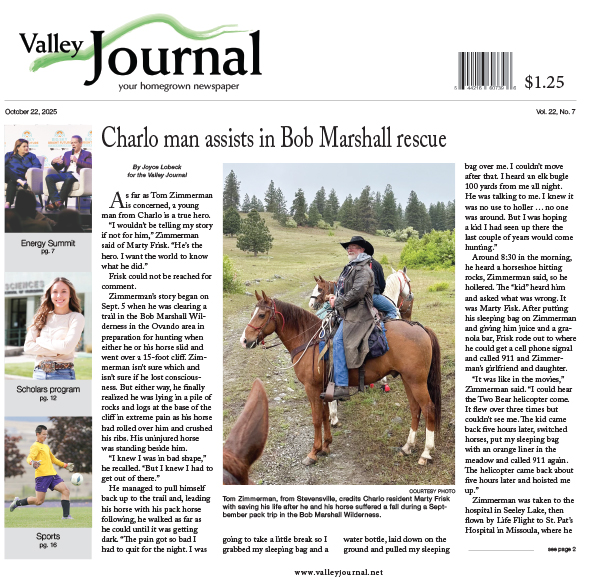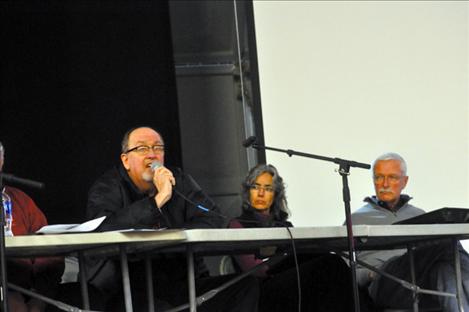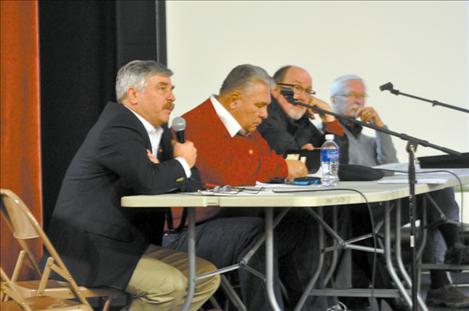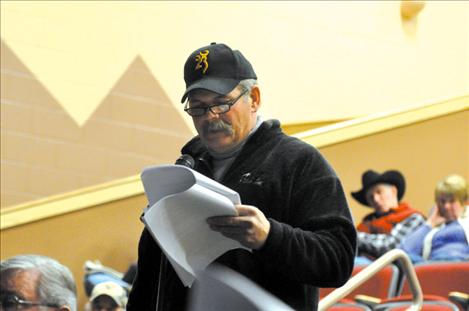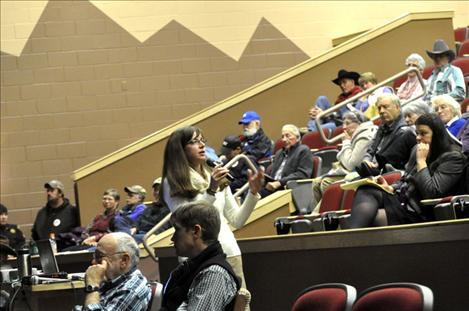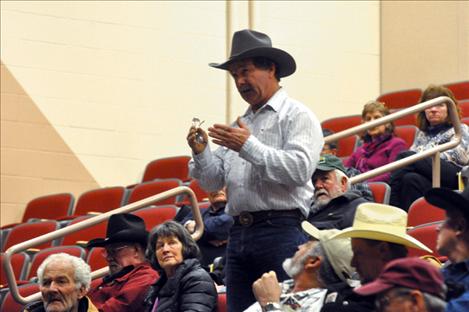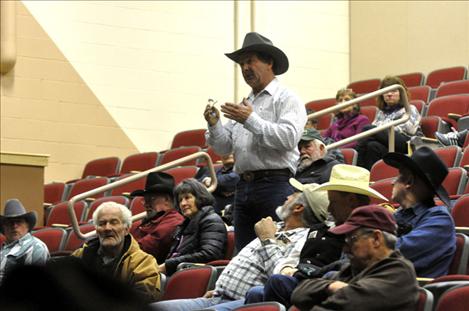Water compact finalized, public speaks out
Hey savvy news reader! Thanks for choosing local.
You are now reading
1 of 3 free articles.
RONAN – State officials were expected to vote Monday night on sending a proposed water compact to the state legislature that would settle the Confederated Salish and Kootenai Tribes’ water claims, after listening sessions were heard in Ronan and Kalispell over the weekend on the matter.
Irrigators and residential water users have separate sets of concerns and impacts that will result if the compact does or does not pass ahead of a June 30 deadline the Tribes have to file their claims in Montana Water Court. If the compact does not pass, representatives for the Tribes have said that they will file as many as 10,000 claims in court, on and off the Flathead Reservation, stretching as far as Billings.
Non-irrigators
Most of the hubbub about the compact in 2014 revolved around revision of certain provisions proposed in a previous 2013 version of the document that failed to be ratified by the state legislature at the time. The revisions centered predominantly around protections for approximately 1,500 farmers and ranchers who receive water from the Flathead Indian Irrigation Project. The part of the compact that remained largely untouched pertains to far more non-irrigators who have claims for wells within reservation boundaries.
The compact quantifies the Tribes’ on and off reservation rights and creates a Unitary Management Ordinance that will provide for administration of water rights on the reservation after the compact is enacted. The ordinance is modeled after state law, Montana Reserved Water Rights Compact Commission Attorney Melissa Hornbein said. It creates a unitary management board that will be tasked with handling some elements of future water management on the reservation. The board is comprised of equal numbers of tribal and non-tribal members.
“It applies only on the reservation,” Hornbein said. “It provides for new permitting going forward, changes of use, basically the whole administrative structure that has not existed on the reservation for the past 18 years as the result of Montana Supreme Court decisions that said the DNRC lacked jurisdiction to permit new uses of water on the reservation.”
As many as 1,700 residential wells are currently in administrative limbo because they have either been filed at the DNRC since 1996 and not processed because of legal injunction, or haven’t been filed upon at all. The outlaw wells include some major sources of water for cities and municipalities, including the City of Polson.
Those wells would be grandfathered in and not subject to call under the compact.
“Even so, the compact and the water rights that are quantified by it will have to be brought to the Montana Water Court to be incorporated into a final decree,” Hornbein said. “The compact will go through a very similar process to individually filed claims. There will be hearings.”
That means people who want to take their water claims to court will still be able to be heard in the state’s water court, Hornbein said. Without the compact, the Montana Water Court is under no obligation to recognize the wells that have been drilled for existing uses and those wells may be subject to call, state officials said.
Non-irrigators off the reservation will also not be subjected to a water battle over claims to streams under the compact. The Tribes have limited their off-reservation claims to eight new in-stream rights. State officials predict little impact to the handful of people who currently have rights in those streams, as most of the rights would only take effect under certain circumstances, such as dam removal.
Some anti-compact advocates have argued that the Tribes should receive no rights off-reservation because none of the other five tribal water compacts in the Montana have granted tribes off-reservation rights. But the Confederated Salish and Kootenai Tribes were granted a reservation through a different type of treaty than the five other tribes. The United States Supreme Court has not ruled on the extent of the Steven’s Treaties’ rights, though some circuit courts and state supreme courts have established that it can create an easement on private property off or entitle tribes to half of the fishery.
State officials considered the risk of the Tribes filing rights on streams throughout western Montana and east of the continental divide to be significant, so it agreed to settle off-reservation claims to the eight in the compact, west of the continental divide.
“In all cases, (Tribes rights) are only enforceable against surface water irrigators and ground water irrigators who are using more than 100 gallons per minute,” Hornbein said. “There are a number of protections placed on these eight rights.”
Hornbein said the compact is a settlement, so no one got all of what they wanted, but that the state’s negotiating team believes the deal is fair.
“This seemed, to the state, to be a very favorable settlement agreement,” Hornbein said. “It recognizes tribal rights and at the same time protects existing uses. It’s not the only way to do it. The Tribes can file their claims and we can see what the courts say, but the way we’ve chosen to do it under the compact is a very limited impact that it has on existing uses.”
The non-irrigation portions of the compact would take effect upon ratification by the state legislature and United States Congress. Other water compacts have languished in Congress in recent years, making it uncertain when the final agreement might go through if the legislature takes up the compact.
Irrigators
The bulk of conversation around the compact for the past year has been the provisions that will determine water delivery to the Flathead Indian Irrigation Project. State, federal and tribal negotiators spent much of the past year renegotiating the irrigation provisions after the Flathead Joint Board of Control dissolved and was legally unable to sign the Water Use Agreement that was an addendum to the compact.
A number of irrigation provisions have changed in the document since 2013. State negotiators said they were able to get a document that is more beneficial to project users.
“A concept that we have incorporated in the new draft of the compact that is distinct from the 2013 version is the concept of delivery entitlement,” Hornbein said. “It is an entitlement to have water delivered and the ability to go to the project operator and get a piece of paper that is a delivery entitlement statement that makes it clear that that piece of water is entitled to have water delivered by the project and that that entitlement runs with the land. That is if you sell your land, the delivery entitlement goes with it.”
Internal delivery of water is also left up to the irrigation project manager in the newest version of the compact. In the 2013 version, individual farm turnouts were intended to receive water based on numbers that were averaged from evapotranspiration models made from satellite data taken in 2007. To quell fears the data wasn’t accurate or thorough enough, the compact negotiators instead decided to write the 2015 version of the document so that water delivery into river diversions will be equal to what has been delivered in two decades of actual data collected by the Confederated Salish and Kootenai Tribes.
“It was important to the state in these renegotiations that the distribution of water keep occurring as it has historically,” Hornbein said. “In other words, the project operator is responsible for distributing water once it is turned into the compact. The compact is simply for quantifying the amount of water that gets turned in.”
Hydrologist Ethan Mace said the technical experts who collected the data are confident it is sound, but because modeling can be faulty, a contingency plan was put in place called “adaptive management.”
“Adaptive management was a pivotal concept,” Mace said.
Adaptive management includes avenues that will allow for more water to be put into the project if it is found that the water delivery specified in the compact is insufficient to meet historic use of irrigators.
New elements of the compact also include a specified hierarchy that will kick in when the Tribes and irrigators share the burden of drought years by undergoing water shortages.
Much of the rest of the compact remains the same as the 2013 version.
It includes $55 million of state funding, $30 million of which will be used for pumping more water into the project, with several million additional dollars devoted to funding rehabilitation and betterment of the project. An unspecified amount of additional federal dollars are anticipated if the bill makes it to the United States Congress.
Farmers like Jan Tusick say that funding will be useful for her operation.
“I’m one of those really, really sloppy irrigators who flood irrigates,” Tusick said, welcoming the idea of funds being made available to upgrade to more efficient water usage. “Our system is archaic.”
Attorney Hertha Lund, who represents irrigators who support the compact, also praised the settlement because it will avoid costly litigation.
“I represent farmers and ranchers from across the state before the water court and let me tell you whenever you have claims involving the federal government it multiplies the cost many times over,” Lund said. “In this case, you will have the federal government as well as the Tribes because the federal government is a trustee of the Tribes. I have some clients who are spending between $5,000 and $10,000 a month adjudicating water claims.”
Lund predicted she will easily be able to retire if the compact doesn’t go through, because the water court will have to sort through claims for the next decade.
But comment for the evening was predominantly anti-compact, as irrigators expressed concerns about the document’s constitutionality and impact to their farms.
“The CSKT Water Comapact is actually very, very simple,” farmer Ross Middlemist said. “You give your precious water rights to tribal government – rights you have bought and paid for – and you give them away for nothing. In exchange you will receive much less water and have more uncertainty from year to year about how much water you will actually receive … You have become a beggar, a slave.”
Middlemist worried about the economic future of his more than 100-year-old farm.
“The blood, sweat and tears we have put into our farms will only be a memory,” Middlemist said. “The food we’ve produced to help feed America becomes a tiny footnote in some USDA report about why America has import more and more about what we eat. We might bump along, but in a few years, we surrender.”
But many in the room vowed not to give up fighting against the compact.
“I’m not going to allow it,” Irrigation Commissioner Shane Orien said. “I’m going to fight it with everything I’ve got … My family wants to be here and wants to farm, to ranch, for however long. (Compact supporters) will not. So the ones supporting this compact aren’t necessarily the ones who are going to have their boots in the mud in this.”
Some vowed to take the issue to the Supreme Court, but Montana Reserved Water Rights Compact Commission Chairman Chris Tweeten said that the statistical likelihood of the issue making it to the high court was small. He said settlements like the compact are usually seen as a preferable solution to litigation.
“It is the same thing that happens in law offices everyday where a lawyers will consider a lawsuit that has been filed and reach an out of court settlement,” Tweeten said. “Both sides would have the option to force that matter in court … but the fact is that 95 percent of litigation in the United States settle. Only five percent are decided on their merits. There is a reason for that and it’s almost universal. A negotiated settlement is preferable to rolling the dice on a win or lose situation in front of the court. Usually the resolution provides something wanted by both sides without giving either side everything they ask for.”
Tweet said the issue can go to court, but state officials hope it doesn’t.
“The water court would be happy to determine who owns the project water right,” Tweeten said. “If the Tribes win, the consequences to the State of Montana are going to be truly dire because (the Tribes) are going to make that argument not only in respect to the counties surrounding the reservation, but in respect to two-thirds of the state of Montana.”















